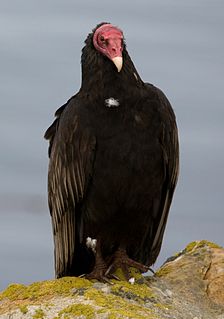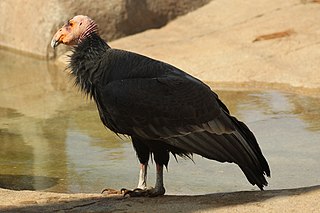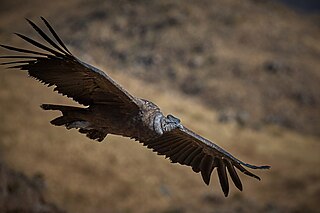 W
WThe New World vulture or condor family, Cathartidae, contains seven extant species in five genera. It includes five extant vultures and two extant condors found in warm and temperate areas of the Americas. The "New World" vultures were widespread in both the Old World and North America during the Neogene.
 W
WThe New World vulture or condor family, Cathartidae, contains seven extant species in five genera. It includes five extant vultures and two extant condors found in warm and temperate areas of the Americas. The "New World" vultures were widespread in both the Old World and North America during the Neogene.
 W
WThe black vulture, also known as the American black vulture, is a bird in the New World vulture family whose range extends from the southeastern United States to Peru, Central Chile and Uruguay in South America. Although a common and widespread species, it has a somewhat more restricted distribution than its compatriot, the turkey vulture, which breeds well into Canada and south to Tierra del Fuego. It is the only extant member of the genus Coragyps, which is in the family Cathartidae. Despite the similar name and appearance, this species is unrelated to the Eurasian black vulture, an Old World vulture in the family Accipitridae. It inhabits relatively open areas which provide scattered forests or shrublands. With a wingspan of 1.5 m (4.9 ft), the black vulture is a large bird though relatively small for a vulture. It has black plumage, a featherless, grayish-black head and neck, and a short, hooked beak.
 W
WThe California condor is a New World vulture, and the largest North American land bird. It became extinct in the wild in 1987, but has since been reintroduced to northern Arizona and southern Utah, the coastal mountains of central and southern California, and northern Baja California. Although four other fossil members are known, it is the only surviving member of the genus Gymnogyps. The species is listed by the IUCN as critically endangered.
 W
WCondor is the common name for two species of New World vultures, each in a monotypic genus. The name derives from the Quechua kuntur. They are the largest flying land birds in the Western Hemisphere.
 W
WThe Andean condor is a South American bird in the New World vulture family Cathartidae and is the only member of the genus Vultur. Found in the Andes mountains and adjacent Pacific coasts of western South America, the Andean condor is the largest flying bird in the world by combined measurement of weight and wingspan. It has a maximum wingspan of 3.3 m exceeded only by the wingspans of four water birds—the roughly 3.5 m maximum of the wandering albatross, southern royal albatross, great white pelican and Dalmatian pelican.
 W
WTeratornithidae is an extinct family of very large birds of prey that lived in North and South America from the Late Oligocene to Late Pleistocene. They include some of the largest known flying birds.